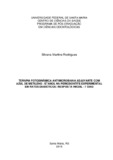| dc.creator | Rodrigues, Silvana Martins | |
| dc.date.accessioned | 2016-12-14 | |
| dc.date.available | 2016-12-14 | |
| dc.date.issued | 2016-07-29 | |
| dc.identifier.citation | RODRIGUES, Silvana Martins. ANTIMICROBIAL PHOTODYNAMIC THERAPY ADJUVANT WITH METHYLENE BLUE / ETHANOL IN PERIODONTITIS EXPERIMENTAL DIABETIC RATS: INITIAL RESPONSE - 7 DAYS. 2016. 85 f. Dissertação (Mestrado em Odontologia) - Universidade Federal de Santa Maria, Santa Maria, 2016. | por |
| dc.identifier.uri | http://repositorio.ufsm.br/handle/1/6193 | |
| dc.description.abstract | In vitro evidences suggested methylene blue (MB) diluted in ethanol improves the antimicrobial photodynamic therapy (aPDT) effect. We hypothesized that aPDT with MB dissolved in ethanol 20% could limit periodontal destruction provoked by ligature in diabetic rats when compared to SRP and aPDT using MB/water. Forty adult male rats received intraperitonial injections of streptozotocin. After 14 d, 5 animals were allocated in the CG, and 35 animals received ligature at the first mandibular molar. After 7 d, the ligature was removed and the animals were randomized into 4 groups: LG (without treatment); and SRPG (SRP), aPDTW (SRP and aPDT with MB 100μg/ml dissolved in water), and aPDTEt (SRP and aPDT with MB 100μg/ml dissolved in water, ethanol and carboxymethylcellulose (77:20:3)). Animals were euthanized at 7 d. Histometric and hematological values were statistically analyzed. The animals percentage presented mild and severe inflammatory infiltrate was: 10% and 40% for SRPG; 20% and 30% for aPDTW; and 50% and 0% for aPDTEt, respectively. SRPG presented statistically higher count of WBC, lymphocytes and monocytes than all the other groups. For bone loss (BL), no statistical difference was observed among aPDTEt (0.08±0.03) and aPDTW (0.21±0.15); and among aPDTW and SRPG (0.30±0.18). aPDTEt BL was significantly lower than SRPG. aPDT, independently of the formulations, showed BL statistically similar to the animals without periodontitis. aPDTEt animals showed collagen content significantly higher than untreated animals (LG), and presented higher mean values than animals without periodontitis, even so the differences don‟t were statistically significant. Collectively, our findings showed aPDTEt presented most promising results, followed for the aPDTW and SRP.We concluded that adjunctive aPDT using MB solubilized ethanol could be an alternative to periodontal treatment in patients who has diabetes. Then, we suggest further studies with more complex animals models and with higher follow-up to confirm our initial findings. | eng |
| dc.description.sponsorship | Coordenação de Aperfeiçoamento de Pessoal de Nível Superior | |
| dc.format | application/pdf | por |
| dc.language | por | por |
| dc.publisher | Universidade Federal de Santa Maria | por |
| dc.rights | Acesso Aberto | por |
| dc.subject | Doença periodontal | por |
| dc.subject | Lasers | por |
| dc.subject | Perda óssea alveolar | por |
| dc.subject | Raspagem e alisamento radicular | por |
| dc.subject | Alveolar bone loss | eng |
| dc.subject | Lasers | eng |
| dc.subject | Periodontal disease | eng |
| dc.subject | Scaling and root planning | eng |
| dc.title | Terapia fotodinâmica antimicrobiana adjuvante
com azul de metileno / etanol na periodontite experimental
em ratos diabéticos: resposta inicial - 7 dias | por |
| dc.title.alternative | Antimicrobial photodynamic therapy adjuvant with methylene blue / ethanol in periodontitis experimental diabetic rats: initial response - 7 days | eng |
| dc.type | Dissertação | por |
| dc.description.resumo | Evidências in vitro sugerem que o azul de metileno (AM) diluído em etanol melhora o efeito antimicrobiano da terapia fotodinâmica (TFDa). Nossa hipótese é que TFDa com AM dissolvido em etanol à 20% poderia limitar a destruição periodontal provocada por ligadura em ratos diabéticos quando comparado com RAR e TFDa usando AM/água. Quarenta ratos machos adultos receberam injeção intraperitoneal de estreptozotocina (STZ). Após 14 dias, 5 animais foram alocados no grupo Controle Negativo (CN), e 35 animais receberam ligadura no primeiro molar inferior. Após 7 dias, a ligadura foi removida e os animais foram divididos aleatoriamente em 4 grupos: Controle Positivo (CP) (sem tratamento); e RAR, TFDAa/água (RAR e TFDa com 100 μg/ml de AM dissolvido em água), e TFDa/etanol (RAR e TFDa com 100 μg/ml de AM dissolvido em água, etanol e carboximetilcelulose (77: 20: 3)). Os animais foram sacrificados após sete dias. Valores histométricos e hematológicos foram analisados estatisticamente. O percentual de animais que apresentaram infiltrado inflamatório moderado a severo foi: 10% e 40% para RAR; 20% e 30% para TFDa/água; e 50% e 0% para a TFDa/etanol, respectivamente. O grupo RAR apresentou estatisticamente maior contagem de glóbulos brancos, linfócitos e monócitos do que todos os outros grupos. Para a perda óssea, não se observou diferença estatística entre TFDa/etanol (0,08 ± 0,03) e TFDa/água (0,21 ± 0,15); e entre aTFDa/água e RAR (0,30 ± 0,18). A perda óssea para o grupo TFDa/etanol foi significativamente menor do que RAR. A TFDa, independentemente das formulações, mostrou perda óssea estatisticamente semelhante ao dos animais sem periodontite. Os animais do grupo TFDa/etanol apresentaram teor de colagéno significativamente maior do que os animais não tratados (CP), e apresentaram valores médios mais elevados do que os animais sem periodontite, mesmo assim as diferenças não foram estatisticamente significativas. Coletivamente, os nossos resultados mostraram que TFDa/etanol apresentou resultados mais promissores, seguido pela TFDa/água e RAR. | por |
| dc.contributor.advisor1 | Kantorski, Karla Zanini | |
| dc.contributor.advisor1Lattes | http://buscatextual.cnpq.br/buscatextual/visualizacv.do?id=K4731767U6 | por |
| dc.contributor.referee1 | Antoniazzi, Raquel Pippi | |
| dc.contributor.referee1Lattes | http://lattes.cnpq.br/2824180535322900 | por |
| dc.contributor.referee2 | Angst, Patrícia Daniela Melchiors | |
| dc.creator.Lattes | http://lattes.cnpq.br/3089698117379379 | por |
| dc.publisher.country | BR | por |
| dc.publisher.department | Odontologia | por |
| dc.publisher.initials | UFSM | por |
| dc.publisher.program | Programa de Pós-Graduação em Ciências Odontológicas | por |
| dc.subject.cnpq | CNPQ::CIENCIAS DA SAUDE::ODONTOLOGIA | por |


